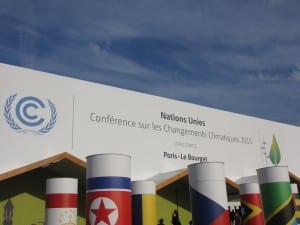‘Observing’ the Paris Climate Change Conference: In the shadow of the Copenhagen Accord in flower
By ucyphaz, on 18 December 2015
Author: Adam Byrne, UCL PhD Student in the Department of Geography
The Paris Agreement that was adopted last Saturday has been greeted with much fanfare and comment from those involved in the process. I had the privilege as a PhD student to attend the COP and was funded by the ESRC doctoral training school. In this brief commentary, rather than offer policy analysis of which there are now already copious amounts, I present here a sketch, as it were, of the COP as I experienced it.
As an accredited ‘observer’ of the COP21 I was not allowed to observe the negotiations under the French presidency other than the open statements of the Comité de Paris, which were broadcast live on the internet in any case. I therefore spent most of the time unable to be a witness to events, which somewhat makes a mockery of the term. In the age of the internet, it was impossible for the UNFCCC and the French government to keep the negotiations completely closed off from the outside world, however, for just as when it rained on Tuesday of the second week and the roof of Hall 4 leaked, some of the delegates tweeted events from behind their security guarded areas, and the information flowed out into the wider world. Beyond this, however, towards the end of the COP it became increasingly difficult for most people, including the vast bulk of the negotiators, to know exactly what was going on as informal consultations and bilateral meetings took place – so much for transparency. This ignorance fostered a sense of fear that the talks might fail, but this fear was misplaced. My belief going into the COP was that there was sufficient political will to mean an agreement was quite likely, and a commitment to the UNFCCC as an institution and process. No national government would want to undermine the negotiations and have the blame for the failure of Paris heaped on their shoulders. Significant diplomatic activities by the French and other governments had occurred in the run up to the conference which also meant the signs were good. The event did not disappoint from this perspective.
This was a highly regulated experience. In fact it was like being in an international airport, in terms of scale, the security process which included the removal of belts and the checking of any liquids, the fact that the conference centre bordered a private airport and the aviation museum, and that the conference halls appeared to be converted plane hangars. Within the site, political action was heavily circumscribed. Walls were kept free from posters, and leaflets were allowed to be left on exhibitor’s tables, but were not allowed to be distributed at the doors. Six designated spaces were allowed for NGO demonstrations, whose political activities were heavily circumscribed due to their diminished numbers through the exclusionary practice of accreditation, and the censorship that was placed on them (e.g. no satirical drawings of Heads of States, negotiators, individuals were allowed). Consequently their actions tended to contain a less offensive interactive novelty element. The long-standing Fossil of the Day Award (which gives out prizes to the worst performing states, e.g. Saudi Arabia) was tongue-in-cheek and clever enough to get past the censorship.
In keeping with the history and location of the Le Bourget Airport site (it was after all the first airport in Paris, and where the American, Charles Lindbergh, completed the first solo nonstop transatlantic flight in 1927), it was a fortunate coincidence that the phrase ‘landing zone’ became an oft repeated phrase in the negotiations for the past year and a half. The image conjured was that of airplane Earth being piloted by the President of the COP, Laurent Fabius, the French foreign minister, to a safe landing zone which accommodated the various positions of the parties. However the analogy and the phrase was an inaccurate one. One of the visual themes of the conference was Noah’s Ark. The offices and the pavilions of the parties were constructed out of some kind of reconstituted wood which made them look hut-like, suitable for animals. A multitude of child-friendly, colourful cartoon-animal acrylic cut-outs lined the main road servicing the Halls which led to a cluster of them outside the plenary hall. This was coordinated by the French artist Gad Weil, and they were reportedly recyclable. Admittedly children were largely absent from the COP, this being a middle-aged and above affair, despite the excellent speech by the 18 year old Marshall Islander, Selina Leem, in the closing statement of the COP. By naming this animal-lined main route the ‘Champs-Élysées’, the organizers demonstrated that they had a sense of humour. The most famous avenue in France this was not. The play on words, intentional or not, is also vaguely sardonic. Champs-Élysées translates as the Elysian Fields, a part of classical Greek religion, which essentially celebrated segregation. The Elysian Fields were a kind of paradise for the chosen few by the gods. There were in fact layers of segregation at the COP21 – VIP areas, areas of a room that couldn’t be moved into, and delegates offices which although not guarded, the doors of which presented as psychological barriers.
As all those with accreditation from the climate change gods will know, paradise at the COP21 became the simple pleasure of a good night sleep. Should we be worried about the long list of ‘errors’ that were read out before the Agreement was adopted, and which were supposedly put down to sleep deprivation? Perhaps. Sleep deprivation makes for an interesting diplomatic strategy and is a handy excuse for creating legal imprecision, as the legal requirement for developed countries to reduce their greenhouse gas emissions in Article 4.4 was downgraded to soft law at the 11th hour after protest by the US. Anyone hoping for a break in the tradition of US domestic politics determining climate change policy at the international level was going to be disappointed, the US team had an excellent conference in this sense – they managed to avoid both domestic political oversight and international commitments in one foul swoop, quite an achievement.
In truth the COP process represented not an individual pilot struggling through a difficult landing, but rather a metaphorical Noah, with preconceived ideas, sorting the animals two-by-two in readiness to resume the journey. The parties had spent the equivalent of 4 years packing for their trip, and having hauled their luggage up to the check-in desk were only to be told that some things could not be brought on board. Noah knew what was needed – the Copenhagen Accord incorporated into international law plus some additions. An agreement that was applicable to all yet incorporated differentiation and set out a long-term framework. An agreement which represents hybridity between international and national, law and politics. Yet in sorting the wants and desires of the parties, stuff was excluded: legally binding targets, the aviation and maritime sectors, liability and compensation, stringent reporting procedures. Some states effectively ceded physical territory, bits of small island developing states weren’t allowed on board. As one attended the side-events and other activities beyond the conference halls, one became more fully aware of the impossibility of attempting to incorporate climate change into a legal text, and the futility of thinking about it in terms such as ‘legal process’ – folded up, the Paris Agreement fits nicely into the back pocket.
As the climate change plane hurtles down the runway to its uncertain destination with rain falling, and the pilots still squabbling and grumbling over who is at the controls, expect backtracking and wriggling at future COPs as decisions to implement the Agreement are taken.
 Close
Close



